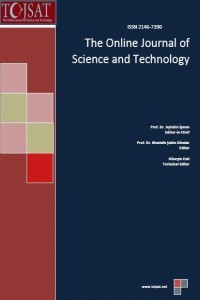ISOLATION, CHARACTERIZATION AND MICROENCAPSULATION OF PROBIOTIC Lactobacillus curvatus G7 FROM CHICKEN CROP
ISOLATION, CHARACTERIZATION AND MICROENCAPSULATION OF PROBIOTIC Lactobacillus curvatus G7 FROM CHICKEN CROP
Lactobacillus curvatus, probiotic, microencapsulation, chicken crop,
___
- Awad W. A., Ghareeb K., Abdel-Raheem S. and Bohm J. 2009. Effects of dietary inclusion of probiotic and symbiotic on growth performance, organ weights, and intestinal histomorphology of broiler chickens. Poult. Sci. 88: 49-55.
- Bergey D. H. and Holt J. G. 1994. Bergey's Manual of Determinative Bacteriology. 9th Ed. Lippincott Williams & Wilkins. US.
- Boyawal P., Lebrum A. and Goulet J. 1985. Etude de l’immobilisation de LB. helveticus dans des billes d’alginate de calcium. Lait, 65:185.189.
- Crittenden R., Weerakkody R., Sanguansri L. and Augustin M. 2006. Synbiotic microcapsules that enhance microbial viability during nonrefrigerated storage and gastrointestinal transit. Appl. Environ. Microbiol. 72(3): 2280-2282.
- Ding W. K. and Shah N. P. 2007. Acid, bile, and heat Tolerance of free and microencapsulated probiotic bacteria. J. Food Sci. 72 (9): 446–450.
- Fuller R. and Turvey A. 1997. Bacteria associated with intestinal wall of the fowl. J. Appl. Bacteriol. 44: 75- 80.
- Fuller R. 1984. Microbial activity in the alimentary tract of birds. Production and Nutrition. 43: 55-61.
- Gabriel I., Mallet S. and Sibill P. 2005. La microflore digestive des volailles: facteurs de variation et conséquences pour l'animal. INRA, Nouzilly, France: 309-222.
- Gournier-Château N., Larpent J. P., Castillanos M.I. and Larpent J. L. 1994. Les probiotiques en alimentation animale et humaine. Technique et Documentation. Lavoisier : 1-129.
- Higgins J. P., Higgins S. E., Wolfenden A. D., Henderson S. N., Torres-Rodriguez A., Vicente J. L. Hargis B.
- M. and Tellez G. 2010. Effect of lactic acid bacteria probiotic culture treatment timing on Salmonella enteritidis in neonatal broilers. Poult. Sci. 89: 243-247.
- FAO/OMS Rapport d’experts. 2001. Health and nutritional properties of probiotics in food including powder milk with live lactic acid bacteria.
- Kailasapathy K. 2002. Microencapsulation of probiotic Bacteria: technology and potential applications. Curr. Iss. Intest. Microbiol ; 3: 39-48.
- Lee K. I. and Heo T. R. 2000. Survival of Bifidobacterium longum immobilized in calcium alginate beads in simulated gastric juices and bile salt solution. Appl. Environ. Microbiol. 66: 869-973.
- Lee J. S., Cha D. S. and Park H. J. 2004. Survival of freeze-dried Lactobacillus bulgaricus KFRI 673 in chitosan-coated calcium alginate microparticles. J. Agri. Food Chem. 72:7300-7305.
- Lin W. H., Yu B., Jang S.H. and Tsen H. Y. 2007. Different probiotic properties for Lactobacillus fermentum strains isolated from swine and poultry. Anaerobe. 13: 107-113.
- Lutful Kabir S. M. 2009. The role of probiotics in the poultry industry. Int. J. Mol. Sci. 10: 3531-3546.
- Pacheco K. C., Del Toro G. V., Martinez F. R. and Duran-Paramo. 2010. Am. J. Agri. Biol. Sci. 5(1): 37-42.
- Reque F. E., Pandey1., Franco S. G. and Soccol C. R. 2000. Isolation, identification and physiological study of Lactobacillus fermentum LBP for use as probiotic in chickens. Braz. J. Microbiol. 31:303-307.
- Robin J. M. and Rouchy A. 2001. Les probiotiques. Nutrithérapie INFO. Roy D., Amiot J., Boutin Y. and Lamoureux M. 2006. Innocuité, Qualité et Efficacité des probiotiques. Biotechnologie des cultures lactiques d’intérêt laitier et probiotique. Canada.
- Shahidi F. and Han X. Q. 1993. Encapsulation of food ingredients. Crit. Rev. Food Sci. Nutr. 33(6): 501-547.
- Simova E. D., Beshkova D. B. and Dimitrov Z. P. 2009. Characterization and antimicrobial spectrum of bacteriocins produced by lactic acid bacteria isolated from traditional Bulgarian dairy products. J. Appl. Microbiol., 106: 692-701.
- Soomro A. H, Masud T. and Anwaar K. 2002. Role of lactic acid bacteria (LAB) in food reservation and Human Health: A Review. Pak. J. Nutr., 1: 20-24.
- Sultana K., Godward G., Reynolds N., Arumugasawamy R., Peiris P. and Kailasspathy K. 2000. Encapsulation of probiotic bacteria with alginate- starch and evaluation of survival in simulated gastrointestinal conditions and in yoghurt. Int. J. Food Microbiol. 62:47-55.
- Tagg J. R., Dajani A. S. and Wannamaker L. W. 1976. Bacteriocins of Gram positive bacteria. Bacteriol. Rev. 40: 722-756.
- Vidhyalakshmi R., Bhakyyaraj R. and Subhasree R. S. 2009. Encapsulation. « The future of Probiotics ». Adv. Biol. Res. 3: 96-103.
- Voo W., Ravindra P., Tey B. T. and Chan E. S. 2011. Comparison of alginate and pectin based beads for production of poultry probiotic cells. J. Biosci. Bioeng. 111(3): 294-299.
- ISSN: 2146-7390
- Başlangıç: 2011
- Yayıncı: The association of science, education and technology
BIODEGRADATION OF PESTICIDE: BROMUCONAZOL BY MICROBIAL CONSORTIUM IN BIPHASIC SYSTEM
Ouahiba BORDJIBA, Nouha OUARTSI, Ryad DJERIBI
A CFD MODEL FOR SIMULATING URBAN FLOW IN COMPLEX MORPHOLOGICAL STREET NETWORK
Saddok Houda, Noureddine Zemmouri, Abdelmalek Hasseine, Rachid Athmani, Rafik Belarbi
SMALL ROV TO DETECTION AND IDENTIFICATION OF DANGEROUS UNDERWATER OBJECTS
Jerzy Garus, Agnieszka Studanska
Adnan Aldemir, Suna Ertunç, Hale Hapoğlu, Mustafa Alpbaz
Mohamed Sifour, Idoui Tayeb, Houria Ouled Haddar, Heba Namous, Salima Aissaoui
Suree Nanasombat, Kanittha Khanha, Jiraporn Phan-im, Jutatip Jitaied, Saranya Wannasomboon, Sarissa Patradisakorn, Anusa Wongsil
CHEMICAL MODIFICATION OF WATER HYACINTH FOR THE REMOVAL OF DYESTUFFS
Winai Somboon, Vanida Bhavakul, Suntud Sirianuntapiboon
WATER EFFECT ON DETERIORATIONS OF ASPHALT PAVEMENTS
Houria Ouled-Haddar, Tayeb Idoui, Mohamed Sifour, Messaouda Guezira, Messaouda Bouthabet
Oluwole Abimbola, Tyler Bowling, Bahadir Edizer, Heather Kunze, John Thistlethwaite
